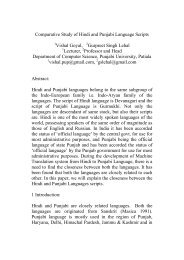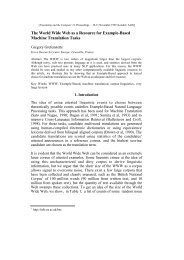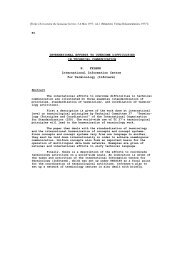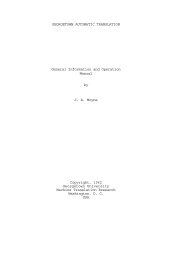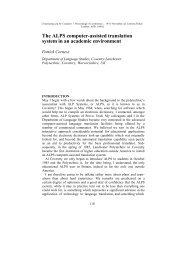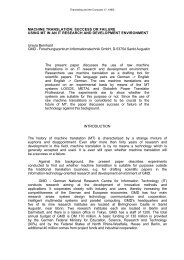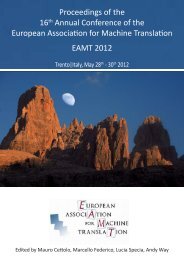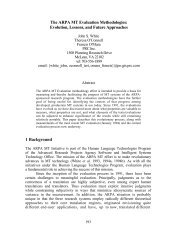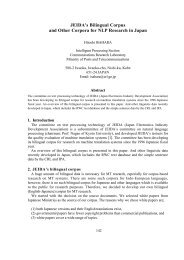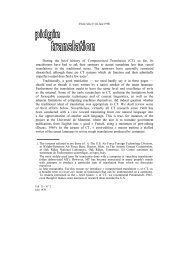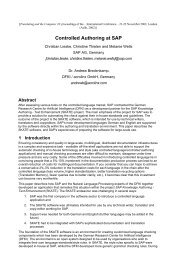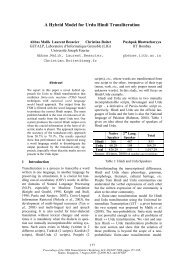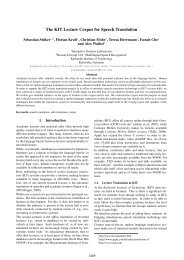Translation - Machine Translation Archive
Translation - Machine Translation Archive
Translation - Machine Translation Archive
Create successful ePaper yourself
Turn your PDF publications into a flip-book with our unique Google optimized e-Paper software.
[Reproduced by permission of the Rockefeller Foundation <strong>Archive</strong>s.]<br />
The attached memorandum on translation from one language<br />
to another, and on the possibility of contributing to this process<br />
by the use of modern computing devices of very high speed, capacity,<br />
and logical flexibility, has been written with one hope only - that<br />
it might possibly serve in some small way as a stimulus to someone<br />
else, who would have the techniques, the knowledge, and the<br />
imagination to do something about it.<br />
I have worried a good deal about the probable naivete of<br />
the ideas here presented; but the subject seems to me so important<br />
that I am willing to expose my ignorance, hoping that it will be<br />
slightly shielded by my intentions.<br />
Warren Weaver<br />
The Rockefeller Foundation<br />
49 West 49th Street<br />
New York 20, New York
l) Preliminary Remarks<br />
TRANSLATION<br />
There is no need to do more than mention the obvious fact that a<br />
multiplicity of language impedes cultural interchange between the peoples<br />
of the earth, and is a serious deterrent to international understanding.<br />
The present memorandum, assuming the validity and importance of this fact,<br />
contains some comments and suggestions bearing on the possibility of<br />
contributing at least something to the solution of the world-wide transla-<br />
tion problem through the use of electronic computers of great capacity,<br />
flexibility, and speed.<br />
The suggestions of this memorandum will surely be incomplete and<br />
naïve, and may well be patently silly to an expert in the field - for the<br />
author is certainly not such.<br />
2) A War Anecdote - Language Invarients<br />
During the war a distinguished mathematician whom we will call<br />
P, an ex-German who had spent some time at the University of Istanbul and<br />
had learned Turkish there, told W.W. the following story.<br />
A mathematical colleague, knowing that P had an amateur interest<br />
in cryptography, came to P one morning, stated that he had worked out a<br />
deciphering technique, and asked P to cook up some coded message on which<br />
he might try his scheme. P wrote out in Turkish a message containing about<br />
100 words; simplified it by replacing the Turkish letters ç, ğ, ĭ, ö, ş,<br />
and ü by c, g, i, o, s, and u respectively; and then, using something more<br />
complicated than a simple substitution cipher, reduced the message to a<br />
column of five digit numbers. The next day (and the time required is<br />
significant) the colleague brought his result back, and remarked that they<br />
had apparently not had success. But the sequence of letters he reported,
- 2 -<br />
when properly broken up into words, and when mildly corrected (not enough<br />
correction being required really to bother anyone who knew the language<br />
well), turned out to be the original message in Turkish.<br />
The most important point, at least for present purposes, is that<br />
the decoding was done by someone who did not know Turkish, and did not<br />
know that the message was in Turkish. One remembers, by contrast, the<br />
well-known instance in World War I when it took our cryptographic forces<br />
weeks or months to determine that a captured message was coded from<br />
Japanese; and then took them a relatively short time to decipher it, once<br />
they knew what the language was.<br />
During the war, when the whole field of cryptography was so<br />
secret, it did not seem discreet to inquire concerning details of this<br />
story; but one could hardly avoid guessing that this process made use of<br />
frequencies of letters, letter combinations, intervals between letters<br />
and letter combinations, letter patterns, etc., which are to some<br />
significant degree independent of the language used. This at once leads<br />
one to suppose that, in the manifold instances in which man has invented<br />
and developed languages, there are certain invariant properties which are,<br />
again not precisely but to some statistically useful degree, common to<br />
all languages.<br />
This may be, for all I know, a famous theorem of philology.<br />
Indeed the well-known bow-wow, woof-woof, etc. theories of Müller and<br />
others, for the origin of languages, would of course lead one to expect<br />
common features in all languages, due to their essentially similar mechanism<br />
of development. And, in any event, there are obvious reasons which make<br />
the supposition a likely one. All languages - at least all the ones under<br />
consideration here - were invented and developed by men; and all men,
- 3 -<br />
whether Bantu or Greek, Islandic or Peruvian, have essentially the same<br />
equipment to bring to bear on this problem. They have vocal organs<br />
capable of producing about the same set of sounds (with minor exceptions,<br />
such as the glottal click of the African native). Their brains are of<br />
the same general order of potential complexity. The elementary demands<br />
for language must have emerged in closely similar ways in different places<br />
and perhaps at different times. One would expect wide superficial differ-<br />
ences; but it seems very reasonable to expect that certain basic, and<br />
probably very non-obvious, aspects be common to all the developments. It<br />
is just a little like observing that trees differ very widely in many<br />
characteristics, and yet there are basic common characteristics - certain<br />
essential qualities of "tree-ness," - that all trees share, whether they<br />
grow in Poland, or Ceylon, or Colombia. Furthermore (and this is the<br />
important point) a South American has, in general, no difficulty in<br />
recognizing that a Norwegian tree is a tree.<br />
The idea of basic common elements in all languages later received<br />
support from a remark which the mathematician and logician Reichenbach made<br />
to W.W. Reichenbach also spent some time in Istanbul, and like many of<br />
the German scholars who went there, he was perplexed and irritated by the<br />
Turkish language. The grammar of that language seemed to him so grotesque<br />
that eventually he was stimulated to study its logical structure. This,<br />
in turn, led him to become interested in the logical structure of the<br />
grammar of several other languages; and quite unaware of W.W.'s interest<br />
in the subject, Reichenbach remarked, "I was amazed to discover that for<br />
(apparently) widely varying languages, the basic logical structures have<br />
important common features." Reichenbach said he was publishing this, and<br />
would send the material to W.W.; but nothing has ever appeared.
- 4 -<br />
One suspects that there is a great deal of evidence for this<br />
general viewpoint - at least bits of evidence appear spontaneously even<br />
to one who does not see the relevant literature. For example, a note in<br />
Science, about the research in comparative semantics of Erwin Reifler of<br />
Washington University, states that "the Chinese words for 'to shoot' and<br />
'to dismiss' show a remarkable phonological and graphic agreement." This<br />
all seems very strange until one thinks of the two means of "to fire" in<br />
English. Is this only happenstance? How widespread are such correlations?<br />
3) <strong>Translation</strong> and Computers<br />
Having had considerable exposure to computer design problems<br />
during the war, and being aware of the speed, capacity, and logical<br />
flexibility possible in modern electronic computers, it was very natural<br />
for W.W. to think, several years ago, of the possibility that such computers<br />
be used for translation. On March 4, 1947, after having turned this idea<br />
over for a couple of years, W.W. wrote to Professor Norbert Wiener of<br />
Massachusetts Institute of Technology as follows:<br />
"One thing I wanted to ask you about is this. A most<br />
serious problem, for UNESCO and for the constructive and<br />
peaceful future of the planet, is the problem of translation,<br />
as it unavoidably affects the communication between peoples.<br />
Huxley has recently told me that they are appalled by the<br />
magnitude and the importance of the translation job.<br />
"Recognizing fully, even though necessarily vaguely,<br />
the semantic difficulties because of multiple meanings, etc.,<br />
I have wondered if it were unthinkable to design a computer<br />
which would translate. Even if it would translate only<br />
scientific material (where the semantic difficulties are<br />
very notably less), and even if it did produce an inelegant<br />
(but intelligible) result, it would seem to me worth while.<br />
"Also knowing nothing official about, but having guessed<br />
and inferred considerable about, powerful new mechanized<br />
methods in cryptography - methods which I believe succeed<br />
even when one does not know what language has been coded -<br />
one naturally wonders if the problem of translation could<br />
conceivably be treated as a problem in cryptography. When<br />
I look at an article in Russian, I say "This is really written<br />
in English, but it has been coded in some strange symbols.<br />
I will now proceed to decode.
eply:<br />
- 5 -<br />
"Have you ever thought about this? As a linguist and<br />
expert on computers, do you think it is worth thinking about?"<br />
Professor Wiener, in a letter dated April 30, 1947, said in<br />
"Second - as to the problem of mechanical translation,<br />
I frankly am afraid the boundaries of words in different<br />
languages are too vague and the emotional and international<br />
connotations are too extensive to make any quasi mechanical<br />
translation scheme very hopeful. I will admit that basic<br />
English seems to indicate that we can go further than we<br />
have generally done in the mechanization of speech, but you<br />
must remember that in certain respects basic English is the<br />
reverse of mechanical and throws upon such words as 'get,'<br />
a burden, which is much greater than most words carry in<br />
conventional English. At the present time, the mechanization<br />
of language, beyond such a stage as the design of photoelectric<br />
reading opportunities for the blind, seems very premature.<br />
By the way, I have been fascinated by McCulloch's work on<br />
such apparatus, and, as you probably know, he finds the wiring<br />
diagram of apparatus of this kind turns out to be surprisingly<br />
like the microscopic analogy of the visual cortex in the brain."<br />
To this, W.W. replied on May 9, 1947:<br />
"I am disappointed but not surprised by your comments on<br />
the translation problem. The difficulty you mention concerning<br />
Basic seems to me to have a rather easy answer. It is, of<br />
course, true that Basic puts multiple use on an action verb<br />
such as 'get.' But even so, the two-word combinations such<br />
as 'get up,' 'get over,' 'get back,' etc., are, in Basic, not<br />
really very numerous. Suppose we take a vocabulary of 2,000<br />
words, and admit for good measure all the two-word combinations<br />
as if they were single words. The vocabulary is still only<br />
four million: and that is not so formidable a number to a<br />
modern computer, is it?"<br />
Thus this attempt to interest Wiener, who seemed so ideally<br />
equipped to consider the problem, failed to produce any real result. This<br />
must in fact be accepted as exceedingly discouraging, for if there are any<br />
real possibilities, one would expect Wiener to be just the person to<br />
develop them.<br />
The idea has, however, been seriously considered elsewhere.<br />
The first instance known to W.W., subsequent to his own notion about it,<br />
was described in a memorandum dated February 12, 1948, written by
- 6 -<br />
Dr. Andrew D. Booth who, in Professor J. D. Bernal's department in Birkbeck<br />
College, University of London, had been active in computer design and<br />
construction. Dr. Booth said:<br />
"A concluding example, of possible application of the<br />
electronic computer, is that of translating from one language<br />
into another. We have considered this problem in some detail<br />
and it transpires that a machine of the type envisaged could<br />
perform this function without any modification in its design."<br />
On May 25, 1948, W.W. visited Dr. Booth in his computer laboratory<br />
at Welwyn, London; and learned that Dr. Richens, Assistant Director of the<br />
Bureau of Plant Breeding and Genetics, and much concerned with the abstracting<br />
problem, had been interested with Dr. Booth in the translation problem. They<br />
had, at least at that time, not been concerned with the problem of multiple<br />
meaning, word order, idiom, etc.; but only with the problem of mechanizing<br />
a dictionary. Their proposal then was that one first "sense" the letters<br />
of a word, and have the machine see whether or not its memory contains<br />
precisely the word in question. If so, the machine simply produces the<br />
translation (which is the rub; of course "the" translation doesn't exist)<br />
of this word. If this exact word is not contained in the memory, then the<br />
machine discards the last letter of the word, and tries over. If this fails,<br />
it discards another letter, and tries again. After it has found the largest<br />
initial combination of letters which is in the dictionary, it "looks up" the<br />
whole discarded portion in a special "grammatical annex" of the dictionary.<br />
Thus confronted by "running," it might find "run" and then find out what the<br />
ending (n) ing does to "run."<br />
Thus their interest was, at least at that time, confined to the<br />
problem of the mechanization of a dictionary which in a reasonably efficient<br />
way would handle all forms of all words. W.W. has no more recent news of<br />
this affair.
- 7-<br />
Very recently the newspapers have carried stories of the use of<br />
one of the California computers as a translator. The published reports do<br />
not indicate much more than a word-into-word sort of translation, and there<br />
has been no indication, at least that W.W. has seen, of the proposed manner<br />
of handling the problems of multiple meaning, context, word order, etc.<br />
This last named attempt, or planned attempt, has already drawn<br />
forth inevitable scorn; Mr. Max Zeldner, in a letter to the Herald Tribune<br />
on June 13, 1949, stating that the most you could expect of a machine trans-<br />
lation of the fifty-five Hebrew words which form the 23rd Psalm would start<br />
out "Lord my shepherd no I will lack," and would close "But good and kindness<br />
he will chase me all days of my life; and I shall rest in the house of Lord<br />
to length days." Mr. Zeldner points out that a great Hebrew poet once said<br />
that translation "is like kissing your sweetheart through a veil."<br />
It is, in fact, amply clear that a translation procedure that does<br />
little more than handle a one-to-one correspondence of words can not hope to<br />
be useful for problems of "literary" translation, in which style is important,<br />
and in which the problems of idiom, multiple meanings, etc., are frequent.<br />
Even this very restricted type of translation may, however, very<br />
well have important use. Large volumes of technical material might, for<br />
example, be usefully, even if not at all elegantly, handled this way. Technical<br />
writing is unfortunately not always straight-forward and simple in style; but<br />
at least the problem of multiple meaning is enormously simpler. In mathematics,<br />
to take what is probably the easiest example, one can very nearly say that each<br />
word, within the general context of a mathematical article, has one and only<br />
one meaning,<br />
4) The Future of Computer <strong>Translation</strong><br />
The foregoing remarks about computer translation schemes which have<br />
been reported, do not however seem to W.W. to give an appropriately hopeful
- 8 -<br />
indication of what the future possibilities may be. Those possibilities<br />
should doubtless be indicated by persons who have special knowledge of<br />
languages and of their comparative anatomy. But again at the risk of being<br />
foolishly naïve, it seems interesting to indicate four types of attack, on<br />
levels of increasing sophistication.<br />
5) Meaning and Context<br />
First, let us think of a way in which the problem of multiple<br />
meaning can, in principle at least, be solved. If one examines the words<br />
in a book, one at a time as through an opaque mask with a hole in it one<br />
word wide, then it is obviously impossible to determine, one at a time, the<br />
meaning of the words. "Fast" may mean "rapid"; or it may mean "motionless";<br />
and there is no way of telling which.<br />
But if one lengthens the slit in the opaque mask, until one can<br />
see not only the central word in question, but also say N words on either<br />
side, then if N is large enough one can unambiguously decide the meaning of<br />
the central word. The formal truth of this statement becomes clear when<br />
one mentions that the middle word of a whole article or a whole book is<br />
unambiguous if one has read the whole article or book, providing of course<br />
that the article or book is sufficiently well written to communicate at<br />
all.<br />
The practical question is, what minimum value of N will, at least<br />
in a tolerable fraction of cases, lead to the correct choice of meaning<br />
for the central word?<br />
This is a question concerning the statistical semantic character<br />
of language which could certainly be answered, at least in some interesting<br />
and perhaps in a useful way. Clearly N varies with the type of writing in<br />
question. It may be zero for an article known to be about a specific<br />
mathematical subject. It may be very low for chemistry, physics, engineering,<br />
etc. If N were equal to 5, and the article or book in question were on some
- 9 -<br />
sociological subject, would there be a probability of .95 that the choice<br />
of meaning would be correct 98% of the time? Doubtless not: but a statement<br />
of this sort could be made, and values of N could be determined that would<br />
meet given demands.<br />
Ambiguity, moreover, attaches primarily to nouns, verbs, and<br />
adjectives; and actually (at least so I suppose) to relatively few nouns,<br />
verbs, and adjectives. Here again is a good subject for study concerning<br />
the statistical semantic character of languages. But one can imagine using<br />
a value of N that varies from word to word, is zero for "he," "the," etc.,<br />
and which needs to be large only rather occasionally. Or would it determine<br />
unique meaning in a satisfactory fraction of cases, to examine not the 2N<br />
adjacent words, but perhaps the 2N adjacent nouns? What choice of adjacent<br />
words maximizes the probability of correct choice of meaning, and at the same<br />
time leads to a small value of N?<br />
Thus one is led to the concept of a translation process in which,<br />
in determining meaning for a word, account is taken of the immediate (2N<br />
word) context. It would hardly be practical to do this by means of a<br />
generalized dictionary which contains all possible phases 2N+1 words long:<br />
for the number of such phases is horrifying, even to a modern electronic<br />
computer. But it does seen likely that some reasonable way could be found<br />
of using the micro-context to settle the difficult cases of ambiguity.<br />
6) Language and Logic<br />
A more general basis for hoping that a computer could be designed<br />
which would cope with a useful part of the problem of translation is to be<br />
found in a theorem which was proved in 1943 by McCulloch and Pitts.* This<br />
* McCulloch, Warren S. and Pitts, Walter. Bulletin of Mathematical Biophysics,<br />
1943, 5, pp. 115-133.
- 10 -<br />
theorem states that a robot (or a computer) constructed with regenerative loops<br />
of a certain formal character is capable of deducing any legitimate conclusion<br />
from a finite set of premises.<br />
Now there are surely alogical elements in language (intuitive sense<br />
of style, emotional content, etc.) so that again one must be pessimistic about<br />
the problem of literary translation. But insofar as written language is an<br />
expression of logical character, this theorem assures one that the problem<br />
is at least formally solvable.<br />
7) <strong>Translation</strong> and Cryptography<br />
Claude Shannon, of the Bell Telephone Laboratories, has recently<br />
published some remarkable work in the mathematical theory of communication.*<br />
This work all roots back to the statistical characteristics of the communica-<br />
tion process. And it is at so basic a level of generality that it is not<br />
surprising that his theory includes the whole field of cryptography. During<br />
the war Shannon wrote a most important analysis of the whole cryptographic<br />
problem, and this work is, W.W. believes, also to appear soon, it having been<br />
declassified.<br />
Probably only Shannon himself, at this stage, can be a good judge<br />
of the possibilities in this direction; but as was expressed in W.W.'s<br />
original letter to Wiener, it is very tempting to say that a book written in<br />
Chinese is simply a book written in English which was coded into the "Chinese<br />
code." If we have useful methods for solving almost any cryptographic problem,<br />
may it not be that with proper interpretation we already have useful methods<br />
for translation?<br />
* For a very simplified version, see "The Mathematics of Communication," by<br />
Warren Weaver, Scientific American, Vol. 181, No. 1, July 1949, pp. 11-15.<br />
Shannon's original papers, as published in the Bell System Technical<br />
Journal, and a longer and more detailed interpretation by W.W., are about<br />
to appear as a memoir on communication, published by the University of<br />
Illinois Press. A book by Shannon on this subject is also to appear soon.
- 11 -<br />
This approach brings into the foreground an aspect of the matter<br />
that probably is absolutely basic - namely, the statistical character of the<br />
problem. "Perfect" translation is almost surely unattainable. Processes,<br />
which at stated confidence levels will produce a translation which contains<br />
only X per cent "error," are almost surely attainable.<br />
And it is one of the chief purposes of this memorandum to emphasize<br />
that statistical semantic studies should be undertaken, as a necessary<br />
preliminary step.<br />
The cryptographic-translation idea leads very naturally to, and<br />
is in fact a special case of, the fourth and most general suggestion, namely<br />
that translation make deep use of language invariants.<br />
8) Language and Invariants<br />
Indeed, what seems to W.W. to be the most promising approach of<br />
all is one based on the ideas expressed in Section 2 above - that is to say,<br />
an approach that goes so deeply into the structure of languages as to come<br />
down to the level where they exhibit common traits.<br />
Think, by analogy, of individuals living in a series of tall<br />
closed towers, all erected over a common foundation. When they try to com-<br />
municate with one another they shout back and forth, each from his own closed<br />
tower. It is difficult to make the sound penetrate even the nearest towers,<br />
and communication proceeds very poorly indeed. But when an individual goes down<br />
his tower, he finds himself in a great open basement, common to all the towers.<br />
Here he establishes easy and useful communication with the persons who have<br />
also descended from their towers.<br />
Thus may it be true that the way to translate from Chinese to Arabic,<br />
or from Russian to Portuguese, is not to attempt the direct route, shouting<br />
from tower to tower. Perhaps the way is to descend, from each language, down<br />
to the common base of human communication - the real but as yet undiscovered<br />
universal language - and then re-emerge by whatever particular route is convenient.
- 12 -<br />
Such a program involves a presumably tremendous amount of work in<br />
the logical structure of languages before one would be ready for any mechniza-<br />
tion. This must be very closely related to what Ogden and Richards have<br />
already done for English - and perhaps for French and Chinese. But it is along<br />
such general lines that it seems likely that the problem of translation can<br />
be attacked successfully. Such a program has the advantage that, whether or<br />
not it lead to a useful mechanization of the translation problem, it could not<br />
fail to shed much useful light on the general problem of communication.<br />
Warren Weaver<br />
Carlsbad, New Mexico<br />
July 15, 1949



